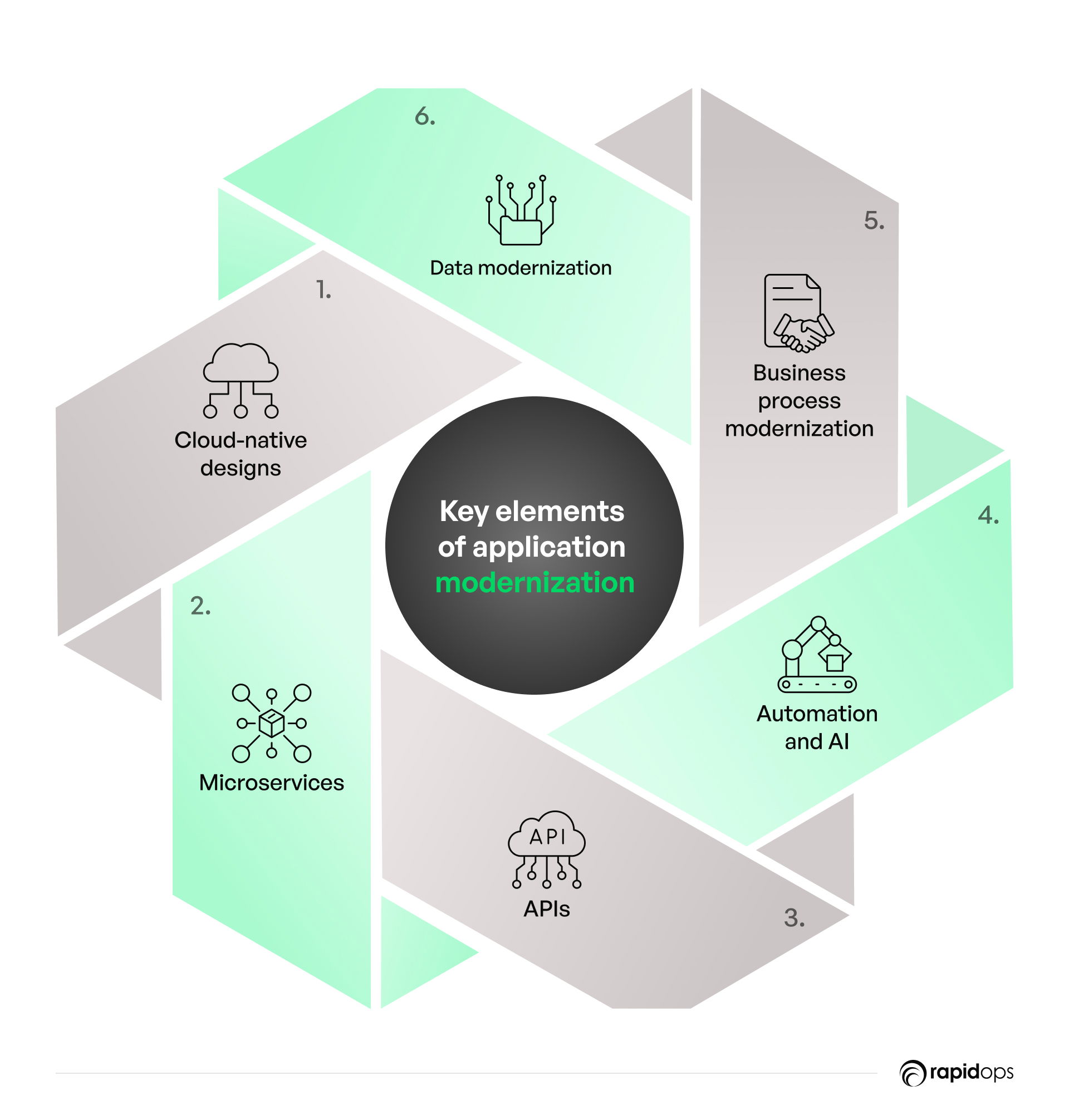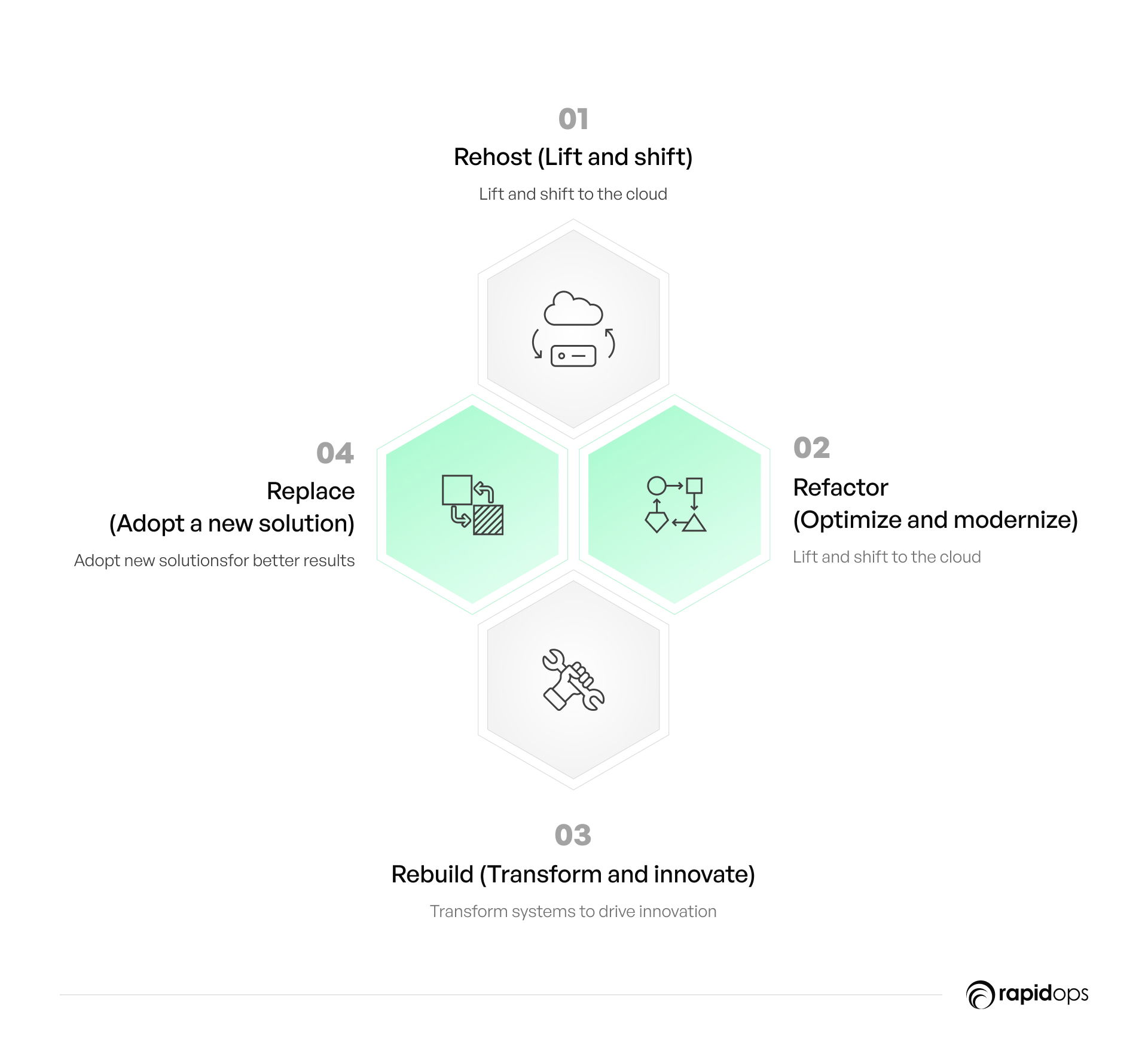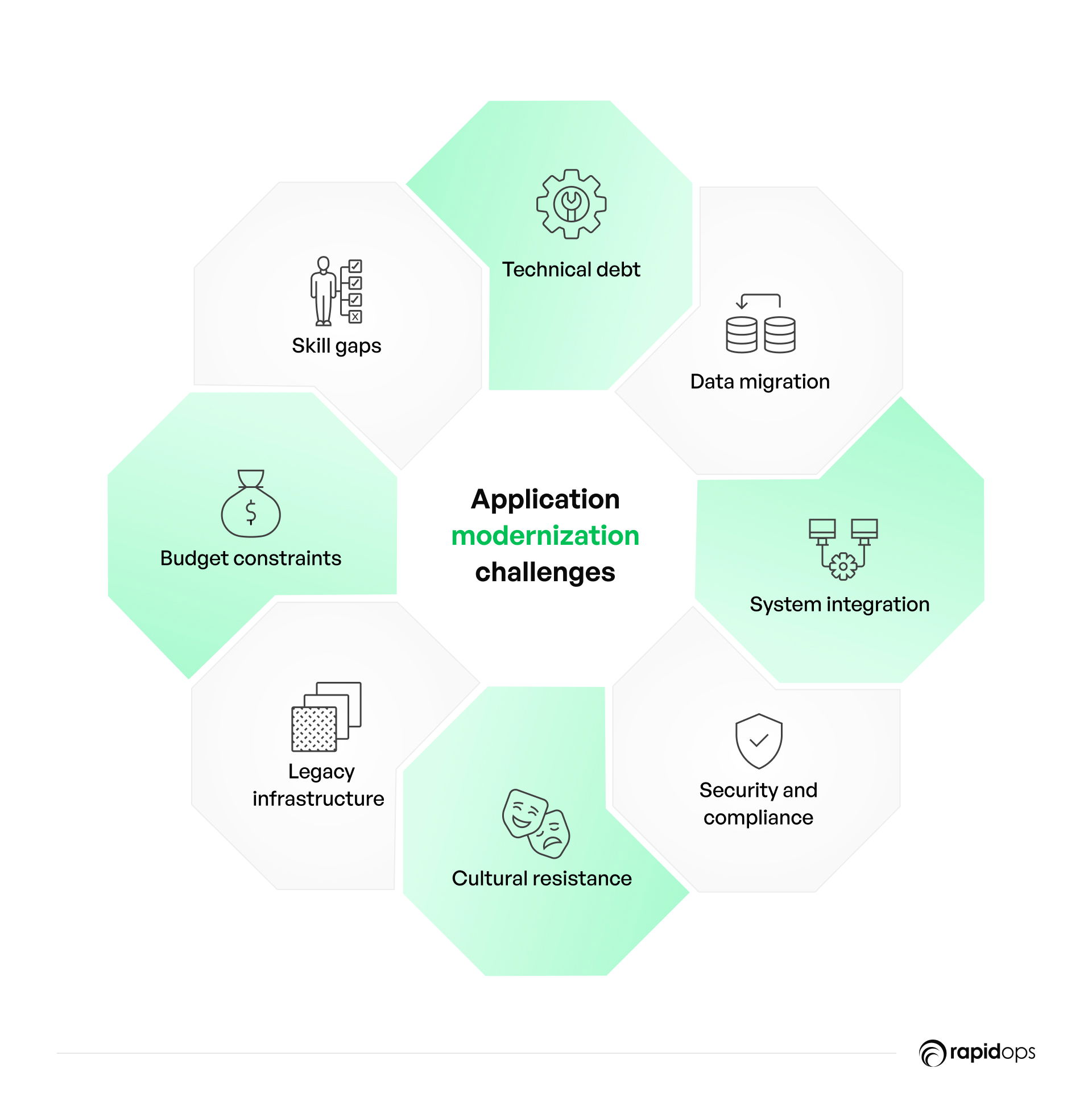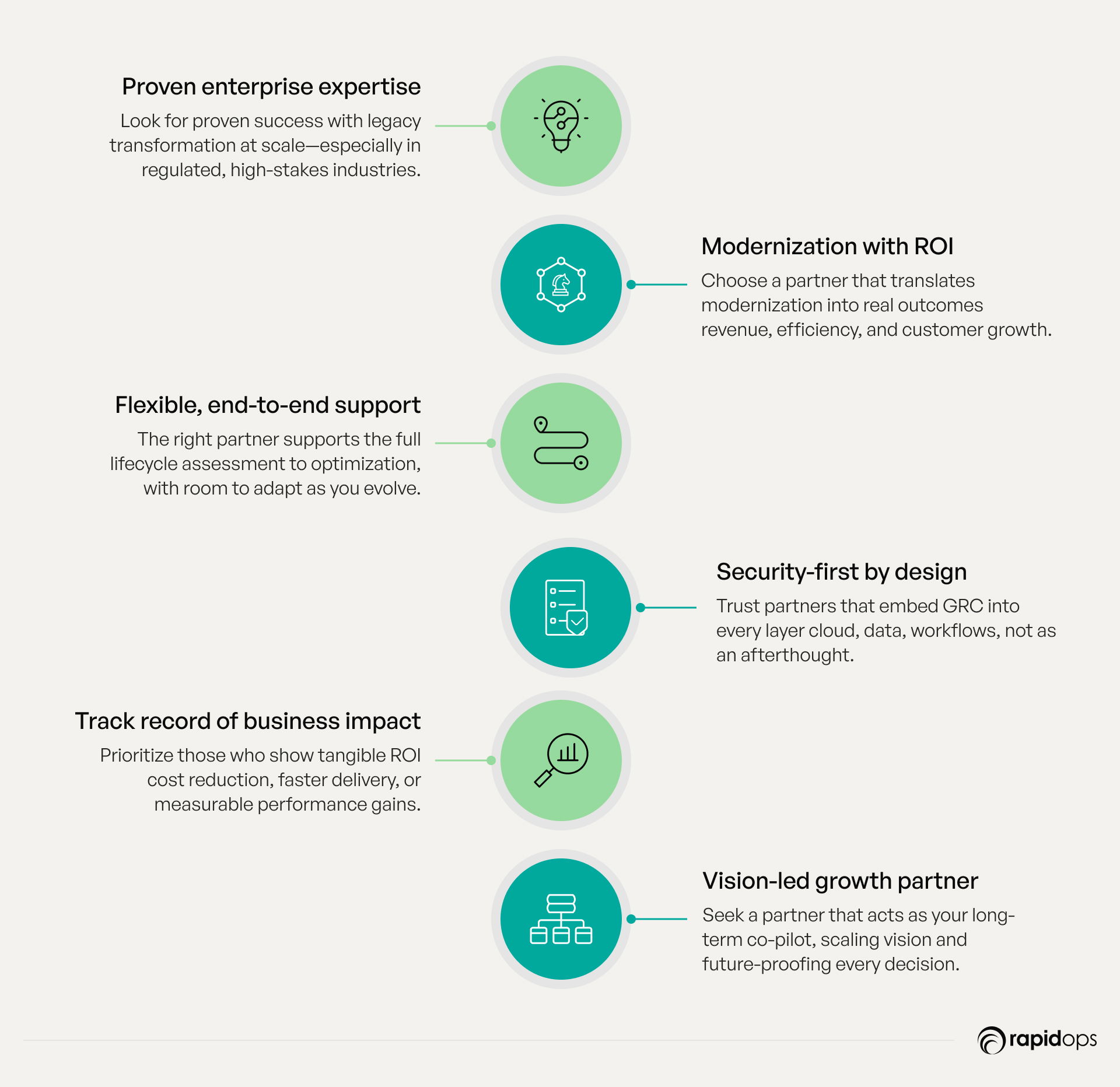Many enterprises underestimate how outdated applications silently erode efficiency until they lose market share. A leading manufacturer recently faced this reality: production delays mounted, inventory systems failed to keep up, and customer complaints surged.
Then came the wake-up call: a competitor, leveraging modern systems, began delivering faster, more reliable service. Leadership realized short-term fixes weren’t enough; they needed a strategic application modernization strategy to stay competitive.
This challenge is widespread. 80% of enterprises risk falling behind due to legacy applications, and 70% of digital transformation efforts stall because of outdated systems. Yet, organizations that take the right approach focusing on cloud adoption, automation, and data-driven decision-making achieve 2.5x higher efficiency and 85% stronger customer satisfaction.
So, what truly drives success when modernizing applications? Which strategies create real business value, and which add unnecessary complexity?
This guide breaks down the core priorities of application modernization, helping you make confident, future-ready decisions that enhance agility, efficiency, and long-term growth.
What is application modernization
Defining application modernization in business terms
As enterprises push deeper into digital transformation, outdated applications are becoming a critical bottleneck slowing growth, reducing efficiency, and constraining innovation. Modernizing applications isn’t just about upgrading technology; it’s about future-proofing operations. Application modernization services help organizations enhance flexibility, optimize costs, and improve customer experiences by transforming legacy systems into scalable, resilient, cloud-native solutions aligned with today’s business goals.
Unlike costly rip-and-replace approaches, legacy application modernization focuses on reengineering existing applications to meet modern business needs. This involves adopting cloud environments public, private, or hybrid along with automation and AI-driven capabilities to maximize scalability and resilience.
Key components of an application modernization strategy
To modernize effectively, organizations need a structured approach that leverages key enablers and tools.

- Cloud-native architectures: Shift workloads to scalable, cost-efficient cloud platforms to enhance agility and reduce IT complexity.
- Microservices: Break monolithic applications into modular services, enabling faster innovation and seamless scaling.
- APIs and integrations: Ensure smooth interoperability between modern and legacy systems, improving collaboration and data accessibility.
- AI-driven application modernization: Automate workflows, enhance decision-making, and drive predictive insights to increase efficiency.
These modernization elements reduce technical debt while enabling businesses to leverage scalable solutions for sustained growth.
The path to future-ready modernization
Investing in future-ready application modernization ensures long-term competitiveness. Whether through cloud migration, process automation, or legacy system transformation, enterprises that modernize strategically are better positioned for sustained growth, operational efficiency, and continuous innovation. That’s why modernization has shifted from an IT initiative to a strategic, non-negotiable business imperative.
What is driving the need for modernization today
Business models across industries are being stress-tested like never before, and many are showing the strain. The urgency to modernize is no longer theoretical, it’s being felt in operational inefficiencies, shrinking margins, and a growing inability to adapt to rapid change.
Externally, market forces are reshaping expectations at speed:
- Customers now demand seamless, real-time digital experiences across all channels.
- Digital-native competitors are launching tailored services faster, setting new benchmarks for personalization and responsiveness.
- Regulatory complexity is increasing, requiring tighter integration, data transparency, and traceability across enterprise systems.
Internally, modernization is being held back by longstanding structural challenges:
- Legacy systems fragment data and hinder real-time decision-making.
- Technical debt built up over years of patchwork fixes inflates the cost of change and slows innovation.
- Siloed processes and outdated architectures block cross-functional agility and scalability.
Business leaders are coming to terms with a hard truth: their current technology landscape is no longer just inefficient, it’s incompatible with the demands of a modern, digital-first market.
What truly matters in application modernization
Modernization has become a strategic mandate, but its real impact depends on where the focus lies. It’s not about adopting the latest frameworks or migrating everything to the cloud, it’s about aligning every effort with business priorities, customer expectations, and long-term adaptability. The initiatives that create lasting value are the ones that reduce friction, enable faster decisions, and support continuous evolution across teams, technologies, and markets.
1. Business-driven outcomes over technology-first thinking
The most successful modernization initiatives begin not with technology, but with business priorities.
C-suite executives must ask:
“What core outcomes are we truly aiming to enable?”
Common enterprise goals include:
- Improving responsiveness to changing customer demands and market dynamics
- Reducing operating costs by eliminating inefficiencies and redundancy
- Accelerating innovation cycles and launching new services faster
- Enhancing end-to-end customer experiences through seamless digital interactions
Technology should follow strategy, not the other way around. This shift ensures that every modernization effort directly supports measurable business value, rather than becoming a siloed IT exercise.
2. Prioritizing applications that deliver the highest impact
Modernization is a journey and trying to modernize everything at once leads to cost overruns, delays, and fragmented progress. What matters most is knowing what to modernize first.
Focus on:
- High-impact applications directly tied to revenue, compliance, or customer experience
- Systems suffering from severe technical debt or frequent maintenance issues
- Applications with limited integration capabilities, blocking data flow and automation
A structured application portfolio assessment helps enterprises map modernization priorities based on business criticality, technical complexity, and future readiness. This ensures resources are deployed where they drive the highest ROI.
3. Embracing cloud-native architecture, with a purpose
Cloud is central to modern application ecosystems, but it’s not a silver bullet. The real value lies in how cloud-native principles are applied.
Key considerations include:
- Selecting the right cloud model public, private, hybrid, or multi-cloud based on performance, data sovereignty, and compliance needs
- Leveraging cloud-native services (containers, Kubernetes, serverless) to increase agility and resilience
- Establishing CI/CD pipelines for faster, automated deployments that reduce human error and downtime
Rather than just lifting and shifting legacy apps, enterprises must rethink architecture for the cloud maximizing elasticity, performance, and cost efficiency.
4. Building for modularity, interoperability, and reuse
Traditional monolithic systems are brittle and hard to evolve. To build future-ready platforms, modernization must emphasize architectural modularity.
What this looks like:
- Designing systems using microservices that can scale independently and reduce time-to-market
- Creating an API-first architecture that enables seamless integration across old and new systems
- Leveraging composable services and reusable components to reduce duplication and accelerate delivery
This approach improves agility, reduces complexity, and prepares the business to respond quickly to change without overhauling the entire stack.
5. Leveraging data and AI as core enablers
Data is the new currency and modernized applications must be able to harness it in real time. AI is not a nice-to-have add-on; it’s a competitive differentiator.
Key elements:
- Unified, accessible data layers for real-time decision-making and visibility
- Embedding AI/ML models into workflows to predict demand, detect anomalies, and personalize experiences
- Implementing intelligent automation to streamline routine tasks and improve employee productivity
Organizations that treat modernization to operationalize data and intelligence see faster returns and greater long-term value.
6. Security and compliance should be embedded from the start
With growing threats and stricter regulations, security can’t be an afterthought. Modernization must embed proactive, policy-driven security at every layer.
Focus areas:
- Zero trust architectures to minimize attack surfaces and enforce identity-based access
- Built-in compliance controls to automate regulatory reporting and reduce audit risks
- End-to-end data protection across environments, from edge to core to cloud
Especially in industries like healthcare, finance, and logistics, secure-by-design modernization reduces exposure and builds trust.
7. Aligning teams, culture, and operating models
Modernization success depends on more than tools. Without cultural alignment and organizational readiness, even the best tech stack will deliver.
What matters most:
- Cross-functional collaboration between IT, business units, and product teams
- Adoption of agile, DevSecOps, and iterative delivery practices
- Investment in reskilling teams to operate and evolve modern platforms
Business leaders must foster a culture of continuous improvement, where modernization becomes part of how the business thinks and operates.
Core approaches to application modernization
Modernization is no longer optional, it’s the foundation for agility, competitiveness, and resilience in today’s fast-changing market. A well-defined enterprise modernization strategy ensures organizations can optimize performance, reduce costs, and stay ahead of industry shifts. However, selecting the right IT modernization strategy requires a clear understanding of available approaches, trade-offs, and long-term impact.
This breakdown of four key strategies provides clear, actionable insights to support confident, informed decision-making.

1. Rehost (Lift and shift)
What it is
Rehosting moves existing applications to a new environment, like the cloud, without altering their core architecture. This approach is fundamental to cloud application modernization and serves as a low-risk entry point for application migration and modernization efforts.
When to use it
- Time-sensitive scaling: Ideal for businesses facing immediate demand surges that legacy application modernization alone cannot handle.
- Cost-conscious scaling: Suitable when budgets limit extensive redevelopment efforts.
- High infrastructure costs tied to outdated on-premises systems.
- Inflexibility in meeting seasonal or unexpected demand spikes.
Pros
- Fast and low-risk migration.
- Minimal operational disruption during the transition.
Trade-offs for decision-making
- Benefit: Quick implementation with reduced upfront costs.
- Limitation: Does not optimize applications for advanced cloud-native capabilities, which may lead to future IT infrastructure modernization needs.
2. Refactor (Optimize and modernize)
What it is
Refactoring modifies the application’s code or architecture to enhance performance and leverage cloud-native features like auto-scaling and advanced analytics. A well-executed application modernization strategy ensures efficient integration of software modernization techniques for long-term success.
When to use it
- Performance-driven modernization: Ideal for systems that are resource-heavy or slow but still meet functional needs.
- Partial optimization: When you want to modernize without the cost or time investment of a full rebuild.
Challenges it addresses
- Operational inefficiencies caused by legacy systems.
- Inability to utilize modern features like real-time analytics or dynamic resource scaling.
Trade-offs for decision-making
- Benefit: Retains core functionality while improving efficiency.
- Limitation: May not resolve deeper structural limitations, requiring further upgrades in the future.
3. Rebuild (Transform and innovate)
What it is
Rebuilding involves re-architecting the application entirely, often transitioning from monolithic systems to microservices for greater agility. This is a core component of enterprise application modernization and ensures a future-ready application modernization strategy that supports innovation.
When to use it
- Future-ready architecture: Ideal when existing systems no longer meet business needs or support innovation.
- Seamless integration: When businesses need to adopt advanced technologies like AI or IoT.
Challenges it addresses
- Legacy systems that stifle growth and innovation.
- Integration challenges with emerging technologies.
Pros
- Highly scalable, flexible, and future proof.
- Fully customizable to evolving business needs.
Trade-offs for decision-making
- Benefit: Long-term scalability and competitive edge through cutting-edge enterprise cloud transformation.
- Limitation: High initial investment of time and resources, with significant organizational change management required.
4. Replace (Adopt a new solution)
What it is
Replacing involves discarding the legacy system entirely and adopting a new, off-the-shelf, or custom-built solution. This ensures full legacy system modernization with tailored application modernization solutions that align with evolving business goals.
When to use it
- Rapid modernization: When outdated systems are beyond repair or too costly to maintain.
- Adoption of advanced capabilities: When new features like AI-driven workflows or advanced security protocols are critical.
Challenges it addresses
- Costly maintenance and operational inefficiencies in legacy systems.
- Lack of compatibility with modern tools or platforms.
Pros
- Eliminates legacy system constraints.
- Provides access to advanced, ready-to-use solutions.
Trade-offs for decision-making
- Benefit: Immediate access to modern functionality.
- Limitation: High upfront costs and potential disruption during implementation.
Which modernization strategy fits your business
| Strategy | Pros | Cons |
| Rehost | Fast, low-risk migration with minimal disruption to existing operations. | Limited cloud optimization; future modernization may still be required. |
| Refactor | Improves efficiency and scalability; better use of modern platforms. | May not fix core architecture; future upgrades could still be needed. |
| Rebuild | Scalable, flexible, and tailored to business needs; future-ready setup. | Requires major investment and change management across teams. |
| Replace | Removes legacy limits; enables instant use of modern, off-the-shelf tools. | Data migration and user training challenges may arise post-switch. |
Making strategic decisions
Modernization is about more than improving systems, it’s about aligning technology with your business’s future. Each approach comes with its benefits and trade-offs, and the right decision depends on:
- Your goals: Quick scalability, long-term flexibility, or gradual modernization.
- Your resources: Budget, timeline, and organizational readiness.
By understanding the implications of each approach, you can modernize with confidence and turn legacy limitations into opportunities for growth and innovation.
Key challenges in application modernization
Modernizing legacy systems isn’t just a technical upgrade, it’s a business imperative. Companies that fail to modernize risk operational inefficiencies, security vulnerabilities, and losing their competitive edge. However, application modernization comes with its own set of enterprise modernization challenges that businesses must navigate carefully.
From technical debt in modernization to IT skill gaps, organizations face a range of IT modernization obstacles that can derail progress if not addressed strategically. This guide explores the most pressing application modernization challenges, shedding light on their impact and why overcoming them is crucial for success.

1. Strategic misalignment between business and IT
Many modernization initiatives begin with technical ambition but lack clear alignment with evolving business priorities. Without a cross-functional agreement on what “modernization success” looks like, efforts become fragmented, driven by siloed KPIs, misaligned timelines, and conflicting objectives. The result is often redundant effort, underutilized solutions, and lost executive sponsorship mid-stream.
2. Deep-rooted technical debt
Legacy applications often carry decades of architectural debt, hard-coded dependencies, outdated frameworks, and undocumented workflows. This makes even minor changes complex and risky. In many organizations, this debt consumes a significant share of IT resources, leaving little capacity to focus on transformation. Worse, technical debt tends to compound over time, making modernization harder the longer it’s postponed.
3. Operational disruption risks
Replatforming or refactoring core business systems introduces serious risks to day-to-day operations. Even with careful planning, dependencies are often underestimated, and critical business functions can be disrupted. These outages don’t just affect internal workflows; they can impact customer experience, revenue continuity, and compliance timelines.
4. Interoperability and data fragmentation
Most enterprise environments are built on a patchwork of legacy systems, custom integrations, and point solutions. Migrating or modernizing one system often exposes latent interoperability issues. Data flows may break. Systems that appeared integrated are revealed to be brittle or manual. Without shared data models and architectural cohesion, modernization efforts can further fragment the enterprise landscape.
5. Talent and expertise gaps
Modern architectures, cloud-native, API-driven, containerized, and AI-augmented demand skills that many internal teams lack. While organizations may have legacy expertise, modernization calls for fluency in entirely new toolchains, practices, and security models. Hiring these skills is expensive; upskilling is time-consuming. The result is often over-reliance on external vendors, creating long-term operational risks and knowledge silos.
6. Multi-cloud and hybrid complexity
While cloud adoption is essential to modernization, operating across hybrid or multi-cloud environments introduces new layers of complexity. Identity management, data residency, service orchestration, and cost optimization become exponentially harder to manage. Decisions made in one business unit can ripple across environments, creating inconsistencies in governance, performance, and cost control.
7. Regulatory and compliance friction
Many legacy systems were not designed with today’s compliance standards in mind, let alone the dynamic, distributed nature of modern apps. As enterprises modernize, they face complex questions around data lineage, encryption standards, audit trails, and policy enforcement. Failure to address these early can result in costly rewrites, failed audits, or legal exposure, especially in regulated industries like finance, healthcare, and logistics.
8. Organizational resistance and change fatigue
Beyond technology, modernization requires shifts in mindset, culture, and accountability. Teams accustomed to legacy workflows may resist change, particularly when new systems alter long-standing processes or job roles. This resistance can quietly undermine transformation efforts, slowing adoption, increasing rework, and diminishing the perceived value of modernization across the organization.
Each challenge represents more than a technical hurdle; it’s a business-critical decision point. True modernization starts with facing these realities head-on, aligning strategy, systems, and culture before any transformation can succeed.
How to spot a modernization partner you can trust
Choosing the right partner for application modernization isn’t just a tactical decision; it’s a strategic commitment with long-term consequences. The wrong choice can stall transformation, inflate costs, and create technical debt.
The right one becomes a force multiplier for speed, scalability, and business impact. Here’s how to identify a partner who’s truly built to modernize at the enterprise level.

1. Proven experience in complex modernization
Modernizing legacy systems in enterprise environments, especially in sectors like manufacturing, distribution, or retail isn’t one-size-fits-all. A credible partner must bring a track record of success in similar high-stakes environments.
What to look for:
- Case studies with measurable impact (e.g., 25% reduction in downtime, improved integration time by 40%)
- Demonstrated ability to navigate real-world constraints: technical debt, hybrid environments, stakeholder resistance
2. Alignment with business strategy, not just technical delivery
True modernization isn’t driven by technology adoption; it’s driven by business value. Your partner must understand how to link modernization efforts to your revenue goals, cost structure, customer experience, and future roadmap.
What to look for:
- Business-driven thinking baked into their approach
- Ability to translate modernization into faster time-to-market, better margins, or improved customer experience
3. End-to-end capabilities with built-in flexibility
Modernization doesn’t end at go-live. You need a partner who offers full lifecycle support, from assessment and architecture to implementation and continuous optimization, with the flexibility to adjust as priorities evolve.
What to look for:
- Multi-phase execution plans with built-in checkpoints
- Post-deployment support and scalability mindset
4. Enterprise-grade security and compliance expertise
Security and compliance can’t be bolted on, they must be integrated from day one. A trustworthy partner will build modernization strategies with governance, risk, and compliance (GRC) embedded at every layer.
What to look for:
- Familiarity with frameworks like HIPAA, GDPR, SOC 2, PCI-DSS
- Secure-by-design methodologies in cloud, data, and integration layers
5. Evidence of measurable business impact
Outcomes matter. The right partner won’t just talk about tools, they’ll show how their work has delivered tangible business improvements.
What to look for:
- ROI-driven narratives, not vague claims
- Results like performance gains, cost savings, or agility improvements quantified and tracked
6. Strategic vision, not just technical execution
A strong partner is not a vendor, they’re a strategic co-pilot. They understand your long-term vision and make decisions today that future-proof your business for what’s next.
What to look for:
- Roadmaps designed for scalability and resilience
- Vision beyond the current project phase
Shaping tomorrow’s success through application modernization
The systems your business runs today will either unlock your future or quietly hold it back.
Modernization isn’t just about replacing old code or moving to the cloud. It’s about building the kind of foundation that enables your organization to evolve faster than the market, respond smarter to change, and innovate without friction. It’s about resilience not just in technology but in how your business thinks, operates, and grows.
Yet navigating that path is rarely simple. Legacy systems are often deeply embedded in processes, people, and culture. That’s why success depends not just on technology but on having the right partner, one who understands the stakes, sees your business holistically, and leads with both technical precision and strategic clarity.
At Rapidops, we treat modernization as a shared responsibility, with your goals at the center of every decision we make. For over 16 years, we’ve helped forward-thinking enterprises in retail, manufacturing, and distribution turn modernization into measurable business momentum. Whether it’s aligning strategy to vision, minimizing disruption, or unlocking untapped value from your systems, we act as a true extension of your team.
Schedule a consultation with our modernization experts to gain tailored, actionable insights focused on your business, priorities, and next move.
How do you prioritize which applications to modernize first?
Start by assessing the business impact of each application. Prioritize those with the most significant operational inefficiencies or those crucial to customer-facing functions. Focus on applications that offer the highest potential for cost reduction, improved time-to-market, and enhanced security. These quick wins drive measurable results and long-term growth.
What happens if you delay application modernization?
Delaying application modernization increases inefficiencies, security risks, and competitive disadvantage. The longer you wait, the harder it becomes to integrate new technologies and maintain your market position.
How can you leverage data in the modernization process to drive strategic decision-making?
Leverage data analytics during modernization to gain insights into customer behavior, operational inefficiencies, and market trends. Use real-time data to drive strategic decisions, optimize processes, and enhance day-to-day operations, ensuring a more efficient and data-driven approach to business growth.
How do you mitigate the risks of data loss during application modernization?
To mitigate the risks of data loss during modernization, establish a solid data backup strategy before initiating any migration or system changes. Leverage incremental backups, real-time data replication, and failover mechanisms to safeguard data throughout the transition, ensuring business continuity and minimizing disruption.
What are the hidden costs of application modernization that you should be prepared for?
Beyond initial costs, hidden expenses may include employee training, third-party software licensing, post-implementation support, and business process reengineering. You may also face indirect costs, such as temporary productivity drops during the transition and ongoing maintenance expenses after modernization.
How do you manage the complexity of integrating legacy systems with modern solutions?
Use API-based integrations and middleware solutions to bridge the gap between legacy systems and new applications. A phased integration strategy, along with careful data synchronization, ensures that modern systems can work alongside existing infrastructure until full migration is completed.

Rahul Chaudhary
Content Writer
With 5 years of experience in AI, software, and digital transformation, I’m passionate about making complex concepts easy to understand and apply. I create content that speaks to business leaders, offering practical, data-driven solutions that help you tackle real challenges and make informed decisions that drive growth.
What’s Inside
- What is application modernization
- What is driving the need for modernization today
- What truly matters in application modernization
- Core approaches to application modernization
- Key challenges in application modernization
- How to spot a modernization partner you can trust
- Shaping tomorrow’s success through application modernization

Let’s build the next big thing!
Share your ideas and vision with us to explore your digital opportunities
Similar Stories
- Transformation
- undefined Mins
- March 2022

- Transformation
- undefined Mins
- March 2020


Receive articles like this in your mailbox
Sign up to get weekly insights & inspiration in your inbox.

